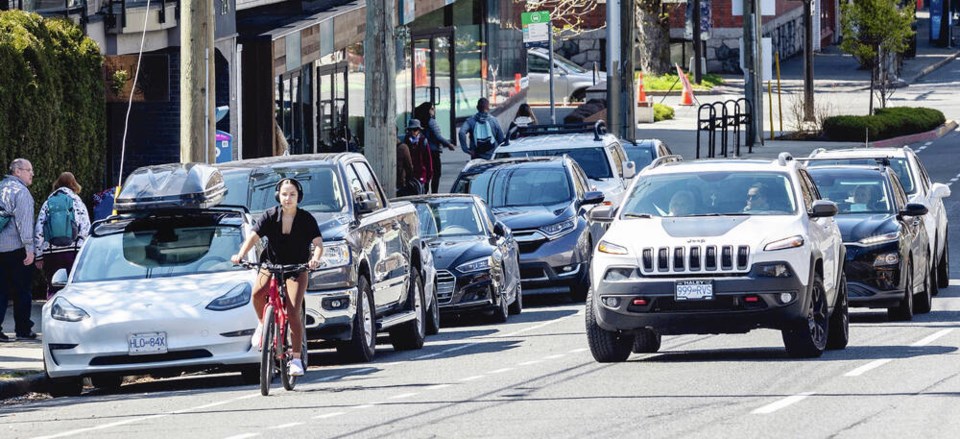There’s some big changes coming to B.C.’s motor vehicle act in the near future. Forty-one amendments and additions, by my count, are being proposed, under Bill 23, as the government tries to keep up with ever increasing number of tech devices hitting our roads coupled with growing demand for greener ways to move through our increasingly crowded provincial roadways.
The changes range from a new definition of a “cycle,” to the requirement for speed limiters on certain commercial vehicles.
B.C.’s news release underscores green, low carbon intentions, but it’s other amendments proposed by Bill 23 that stand out for me.
The new law would create a class of person known as a “vulnerable road user,” defined as a pedestrian, a person operating or riding on a cycle, and someone cryptically described as a “prescribed person.”
The inclusion of the term “prescribed person” probably means regulators are having such trouble keeping pace with everything technology is putting on the road for people to zip around on, that they’re keeping their regulatory options as wide open as possible.
One thing’s for certain, the new laws will require drivers to pay extra attention to those now defined as vulnerable.
For example, it will be a legal requirement for vehicles to give vulnerable road users a wider berth, passing only when it can be done safely and only if a minimum side distance of one metre can be maintained. In practical terms this will often mean falling in behind vulnerable users and waiting until the coast is clear on the left before pulling around them.
It will also be a requirement to adopt a reasonable following distance behind a vulnerable road user depending on road weather and traffic conditions but a minimum following distance, in any circumstance, will be three metres.
There’s no fine schedule attached yet for breaking these rules, but I’m betting they will be substantial. What also caught my eye was that judges imposing sentences for breaking the proposed rules must consider death or the causing of bodily harm as an aggravating factor.
These proposals also change traditional rules about crossing solid lines in order to avoid vulnerable road users. If enacted, you would be allowed to cross over lanes marked with a solid line, cross a line into the oncoming traffic lane, cross over double solid lines or cross over those “no passing” lines, which have both a broken and solid line — the ones meant to restrict passing in your direction of travel.
Now, of course, the caveat is that you can only make these lane crossing manoeuvres when done safely and without affecting the travel of any other vehicle.
Another interesting move is a change to the definition of “pedestrian.” Under the current law a pedestrian is: “a person afoot, or an invalid or a child in a wheelchair or carriage.” The new definition will now include: “a person who is in or on a device that is only capable of being propelled by human power” and: “is, or is similar to, a wheelchair, a stroller, a skateboard, a kick scooter, roller skates, in-line roller skates, skis or a sleigh.” Other “prescribed” mobility devices will also fall into this category.
For decades these gizmos fell into a legal grey area, where no provincial rules seemed to apply. Bill 23 offers up both protections and responsibilities for alternate transport types, where none existed before and that will be a bit of a shake up for some.
Good drivers won’t have much to worry about here but they will need to always keep in the back of their minds the additional and substantial legal liabilities proposed by Bill 23.
Glove Box: Last week’s column about senior drivers prompted several responses including Dr Alexandre Henri-Bhargava, Clinical Associate Professor of Medicine at UBC. As a neurologist who specializes in cognitive disorders such as dementia, Dr Henri-Bhargave points out that when considering potentially unsafe drivers, it is rarely a function of age alone. It’s not about simply being a “senior driver” but often a “senior driver with a medical condition” at the heart of these problems. When medical professionals assess patients, they rarely take action to restrict driving based on age alone. Restrictions happen because of a medical condition or combination of medical conditions that impairs ability for safe driving. Many medical conditions become more common as we age, which means that it is often older drivers who are unsafe. The doctor reminds us that there are some ninety year-olds who are perfectly capable drivers, and yet there are some fifty year-olds who suffer from conditions such as stroke, dementia, or eye diseases that limit their capacity for safe driving. It’s an important point, which the doctor feels the public should always keep in mind, particularly about our perceptions around ageism.
>>> To comment on this article, write a letter to the editor: [email protected]



